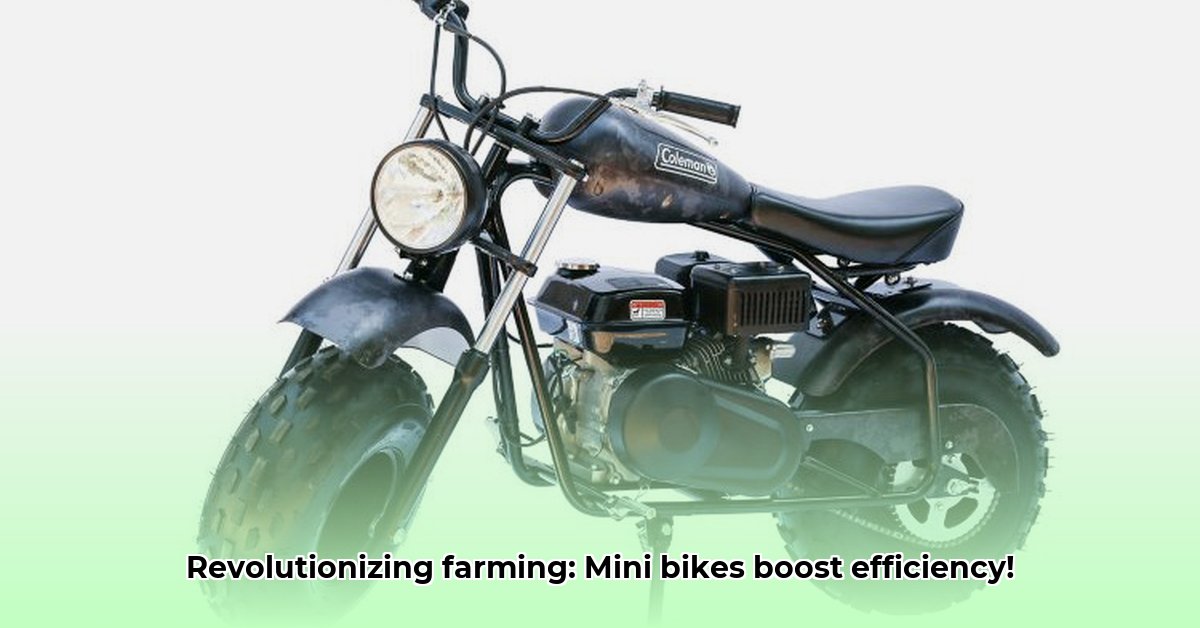
Sustainable farming demands efficiency and resourcefulness. Small-scale farmers often grapple with managing diverse tasks across varied terrain. Tractor Supply's mini bikes offer a surprisingly effective solution, enhancing productivity and minimizing manual labor. For more information on Tractor Supply products, check out their hay spear options. This article explores how mini bikes contribute to sustainable agriculture, guiding you through selection, maintenance, and practical applications.
Why Choose a Mini Bike for Your Farm?
Imagine effortlessly traversing your fields, swiftly inspecting crops, or efficiently transporting small harvests. A mini bike isn't merely a fun ride; it's a versatile tool designed to significantly improve efficiency. Its compact size allows navigation of tight spaces and uneven terrain, often inaccessible to larger equipment. This translates directly into time saved, energy conserved, and reduced physical strain. Is it any wonder that many small-scale farms are embracing this versatile machine?
Selecting the Right Mini Bike: Making an Informed Choice
Choosing the right mini bike hinges on your specific farming needs and terrain. Here's a breakdown of key factors to consider:
Engine Power: Larger engines handle heavier loads and steeper inclines but may consume more fuel. Smaller engines suffice for lighter tasks, offering better fuel economy. The optimum engine size depends on your typical workload. A larger engine might be necessary for hauling heavy loads of harvested produce, while a smaller engine would likely be sufficient for simple crop inspections.
Terrain Type: Rugged terrain demands a mini bike with sturdy tires and effective suspension for a smoother, more comfortable ride. For relatively flat fields, these features are less critical, allowing for a lighter, more fuel-efficient model. Consider the predominant terrain on your farm. Muddy conditions may necessitate a model with aggressive tread tires.
Essential Features: Headlights are crucial for early morning or evening work. A cargo rack expands carrying capacity. Electric start simplifies starting, particularly in cold weather. Weigh the costs and benefits of these features against your specific requirements. A cargo rack could be invaluable for transporting tools and supplies across your fields.
| Feature | Key Considerations |
|---|---|
| Engine Size | Balance power needs (heavy loads vs. light tasks) with fuel efficiency. |
| Tire Type | Choose tires designed for the prevailing terrain (e.g., mud tires for wet conditions). |
| Suspension | Prioritize good suspension for rough or uneven terrain to ensure a comfortable ride. |
| Cargo Capacity | Carefully estimate your typical maximum load weight. |
| Price | Establish a realistic budget and compare models within your price range. |
| Starting System | Consider the convenience of electric start, especially in cold weather. |
Practical Applications on the Farm
The versatility of a Tractor Supply mini bike extends across numerous sustainable farming practices. It's not just about transportation; it's about streamlining your entire workflow:
Crop Inspection: Quickly and efficiently patrol fields, enabling early detection of pests or diseases reducing crop losses and minimizing the need for chemical interventions. Early detection of problems can lead to substantial savings.
Targeted Weed Control: Efficiently transport weeding tools, facilitating focused weed control and reducing herbicide use. This targeted approach minimizes environmental impact and improves resource use.
Harvest Assistance: Effortlessly gather smaller harvests or move produce from the field to storage. This reduces physical strain and maximizes yield. Less physical exertion can increase your efficiency.
Farm Maintenance: Access remote areas for fence repairs, irrigation checks, etc., minimizing downtime and ensuring operational continuity. Efficient maintenance helps maximize your farm's productivity.
Precise Fertilizer Application (with attachments): Some mini bikes can be adapted for precise fertilizer application, minimizing waste and costs, thereby enhancing the environmental sustainability of your operations. Precision fertilizer application can significantly influence your farm's efficiency.
Maintaining Your Mini Bike: A Step-by-Step Guide
Regular maintenance is key to your mini bike's longevity and safe operation. Consult your owner's manual for detailed instructions. Here's a summary of essential tasks:
Step-by-Step Maintenance:
Regular Oil Changes: Adhere to the manufacturer's recommended oil change schedule to ensure optimal engine performance and extend engine life. Neglecting oil changes can dramatically shorten the lifespan of your mini bike.
Tire Pressure Checks: Regularly check and inflate tires to the recommended pressure for improved handling and tire longevity. Proper tire pressure is critical for both performance and safety.
Chain Lubrication: Lubricate the chain regularly to prevent wear, improve performance, and extend the mini bike's lifespan. A well-lubricated chain is essential for efficient operation and safety.
Brake Inspection: Inspect brakes frequently for wear and ensure proper function. Failing to maintain your brakes could have serious safety consequences.
Safety First: Always wear a helmet, gloves, and eye protection. Never operate under the influence of alcohol or drugs. Maintain awareness of your surroundings and operate at a safe speed, especially on uneven terrain.
The Long-Term Benefits: Investing in Efficiency and Sustainability
While an initial investment is required, a mini bike from Tractor Supply frequently offers a strong return on investment through increased efficiency and reduced labor costs. It's a smart investment in the long-term sustainability and success of your farm. The increased efficiency and reduced labor minimize operational costs. Beyond that, reduced strain on your body can lead to increased morale and enjoyment from your daily tasks. The time and money it saves is likely to compensate for purchasing costs.